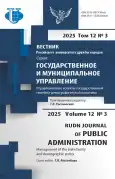Specifics of demographic policy at the regional level: the case of the Republic of Tatarstan
- Autores: Khuramshina A.Z.1,2, Khayrullina Y.R.1,3, Talibova F.T.1
-
Afiliações:
- Family and Demography Center of Tatarstan Academy of Sciences
- Volga Region State University of Physical Culture, Sport and Tourism
- Center of Advanced Economic Research of Tatarstan Academy of Sciences
- Edição: Volume 12, Nº 3 (2025): MANAGEMENT OF THE STATE FAMILY AND DEMOGRAPHIC POLICY
- Páginas: 359-365
- Seção: MANAGEMENT OF THE STATE FAMILY AND DEMOGRAPHIC POLICY
- URL: https://bakhtiniada.ru/2312-8313/article/view/349660
- DOI: https://doi.org/10.22363/2312-8313-2025-12-3-359-365
- EDN: https://elibrary.ru/BSNUCN
- ID: 349660
Citar
Resumo
The study analyzes theoretical approaches to understanding the essence of reproductive behavior, factors influencing its formation, the role and structure of demographic policy. The study considers the specifics of demographic policy, the evolution of Russian experience in managing demographic processes, and provides statistical data. Attention is drawn to the expansion of the range of socio-psychological and socio-cultural motivation of reproductive behavior. The state demographic policy is considered as a response to the challenges of the country’s social development, and the key role of a number of documents is shown. The author shows crucial importance of the national projects “Healthcare”, “Demography”, “Education”, and “Culture” in solving the fertility crisis in the country. Most of the measures to support families with children and stimulate fertility were provided in the national Demography project. Attention is drawn to the launch of the new national project “Family”, which continues the best practices of the Demography project, as well as provides comprehensive support for families with children, reducing poverty, and creating a positive image of having many children. The study systematizes measures of demographic policy at the federal and regional levels, identifies their specifics in the Republic of Tatarstan in the context of changing patterns of reproductive behavior. Regional measures to support families with children and large families are presented in relation to the dynamics of demographic indicators of the republic in the period from the beginning of the 21st century to 2024. During the period of implementation of the measures, a more prosperous demographic state of the Republic of Tatarstan was noted in comparison with the regions of the Volga Federal District and Russia as a whole in terms of fertility and life expectancy. In 2022, the federal total fertility rate was 8.9‰, while the republican birth rate was 9.2‰.
Sobre autores
Aigul Khuramshina
Family and Demography Center of Tatarstan Academy of Sciences; Volga Region State University of Physical Culture, Sport and Tourism
Autor responsável pela correspondência
Email: aigulsuf@mail.ru
ORCID ID: 0000-0002-8384-0616
Código SPIN: 4170-8961
Candidate of Sociological Sciences, Associate Professor, Leading Researcher, Director, Family and Demography Center of Tatarstan Academy of Sciences; Associate Professor of the Department of Social and Humanitarian Disciplines,Volga Region State University of Physical Culture, Sport and Tourism
20 Bauman St., Kazan, Republic of Tatarstan, 420111, Russian Federation; 35 Village Universiade, Kazan, Republic of Tatarstan, 420010, Russian FederationYulduz Khayrullina
Family and Demography Center of Tatarstan Academy of Sciences; Center of Advanced Economic Research of Tatarstan Academy of Sciences
Email: iouldouz@yandex.ru
ORCID ID: 0000-0003-4018-4628
Código SPIN: 6936-5671
Doctor of Sociological Sciences, Professor, Chief Researcher, Center of Advanced Economic Research of Tatarstan Academy of Sciences; Chief Researcher, Family and Demography Center of Tatarstan Academy of Sciences
20 Bauman St., Kazan, Republic of Tatarstan, 420111, Russian Federation; 20 Bauman St., Kazan, Republic of Tatarstan, 420111, Russian FederationFarida Talibova
Family and Demography Center of Tatarstan Academy of Sciences
Email: far.galimova@yandex.ru
ORCID ID: 0009-0009-0440-0187
Código SPIN: 4942-8892
Research Fellow, Family and Demography Center of Tatarstan Academy of Sciences
20 Bauman St., Kazan, Republic of Tatarstan, 420111, Russian FederationBibliografia
- Kuznetsov VN, Rybakovsky LL (eds). Strategiya demograficheskogo razvitiya Rossii [Strategy of demographic development of Russia]. Moscow: Tsentr sots. prognozirovaniya publ.; 2005. (In Russ.).
- Vishnevskii A (ed.). Demograficheskaya modernizatsiya Rossii, 1900–2000 [Demographic modernization of Russia, 1900–2000]. Moscow: Novoe izd-vo publ.; 2006. (In Russ.).
- Urlanis BTs. Evolyutsiya prodolzhitel’nosti zhizni [Evolution of life-span]. Moscow: Statistika publ.; 1978. (In Russ.).
- Antonov AI, Borisov VA. Krizis sem’i i puti ego preodoleniya: nauch. dokl. [Family crisis and ways to overcome it: Sci. Rep.]. Moscow: IS publ.; 1990. (In Russ.).
- Borisov VA. Perspektivy rozhdaemosti [Prospects of fertility]. Moscow: Statistika publ.; 1976. (In Russ.).
- Arkhangel’skii VN. Skol’ko nas budet zavtra? [How many of us will there be tomorrow?]. Nyanya: zhurnal dlya roditelei. 2006;(12):41–44. (In Russ.).
- Antonov AI. Problemy sotsiologicheskogo izucheniya reproduktivnogo povedeniya sem’i [Issues in sociological study of family reproductive behavior]. In Voprosy teorii i metodov sotsiologicheskikh issledovanii [Questions of theory and methods in sociological research]. Moscow; 1974. (In Russ.).
- Khayrullina YuR, Khuramshina AZ. Well-being of children in russian families (based on the materials of the Republic of Tatarstan). Nauchnye trudy Tsentra perspektivnykh ehkonomicheskikh issledovanii. 2024;(26):139–146. (In Russ.). EDN: DLZOOO
- Rustamova GM. Support of public youth initiatives on strengthening family values on the example of the Republic of Tatarstan. Sem’ya i preemstvennost’ pokolenii: materialy Mezhdunarodnogo simpoziuma, Ivanovo — Ples, 30 sentyabrya — 01 oktyabrya 2022 goda [Family and generational continuity: Materials of the International symposium, Ivanovo — Ples, September 30 — October 1, 2022]. Ivanovo: Ivanovskii gosudarstvennyi universitet publ.; 2022:47–51. (In Russ.). EDN: HCZEGG
- Rybakovsky LL, Karelova GN (eds). Demograficheskoe budushchee Rossii [Demographic future of Russia]. Moscow; 2001. (In Russ.).
- Frejka T, Zakharov SV. Fertility trends in Russia during the past half century: period and cohort perspectives. Demographic Review. 2014;1(1):106–143. (In Russ.). EDN: TLMUWZ
- Rybakovsky LL. Demograficheskaya bezopasnost’: populyatsionnye i geopoliticheskie aspekty [Demographic security: population and geopolitical aspects]. Moscow: Ehkon-inform publ.; 2003. (In Russ.).
- Rybakovsky LL. Russia’s demographic future and migration processes. Sotsiologicheskie Issledovaniya. 2005;(3):71–81. (In Russ.). EDN: OOYHJB
Arquivos suplementares










